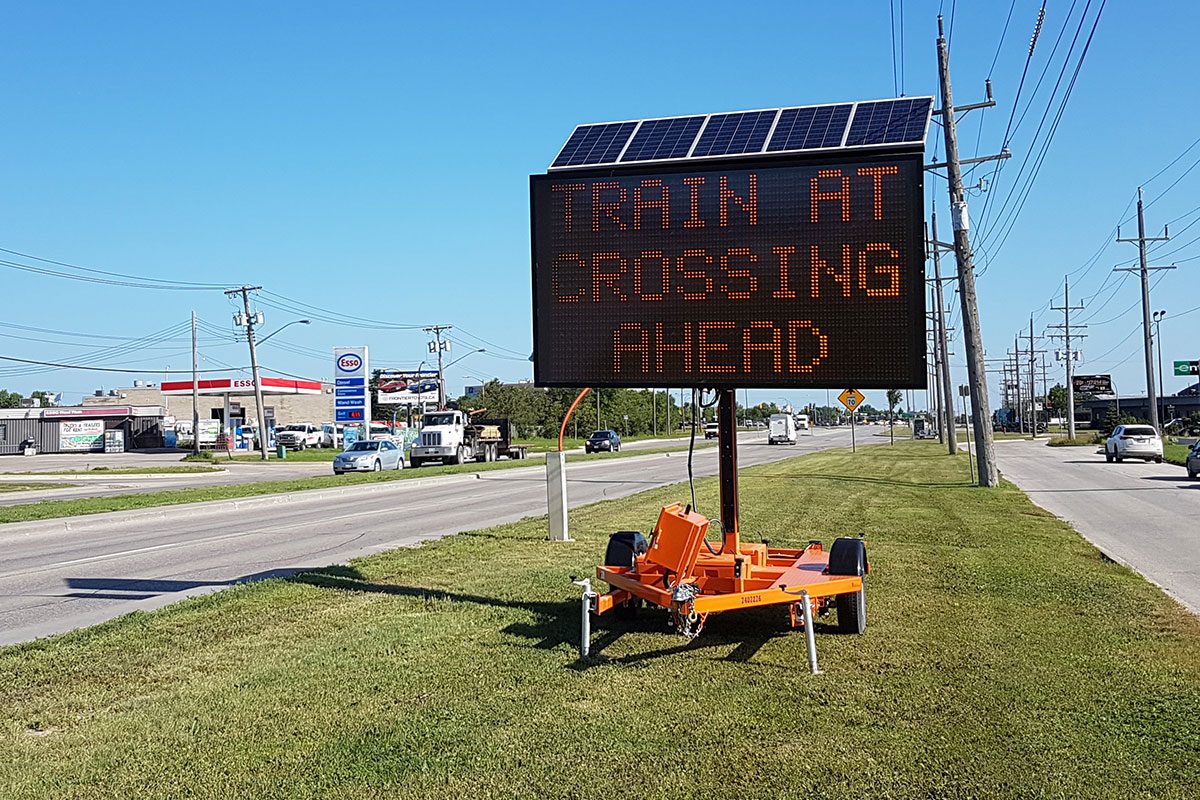
TRAINFO sign on northbound Waverley in Winnipeg.
Trailblazer Talks: Data in the driver’s seat
You’re in your car, travelling down the road in a sea of commuters. But before you can reach your destination, there are flashing red lights ahead. Then the gates go down. You’re approaching a railway crossing with a train imminent; and now, you must wait.
It’s frustrating; you might be late; and, if you’d known about the train, you’d probably have changed your route.
Now, imagine you aren’t a regular commuter but a paramedic transporting a patient to hospital. Or a firefighter on your way to a call. Suddenly, an inconvenient situation becomes life-threatening.
It’s a situation Garreth Rempel [BSc(CE)/06, PhD/11], is trying to prevent. While managing a transportation consulting company fresh out of grad school, he was approached by a firefighter.
“He said, ‘you know, I’m getting stuck at railway crossings all the time. Do you know of anything I can use to avoid them? Because there’s a big risk here for obvious reasons.’” Rempel recalls. “I just assumed there would be something I could find that existed. But I had to get back to him and say, ‘sorry, you’re out of luck.’”
That was 2014. Today, first-responders, bus operators, truck drivers and the average citizen can use TRAINFO to avoid delays at railway crossings.
Co-founded by Rempel, Neil Ternowetsky [BEnvSc./03], with Jeannette Montufar [BSc(CE)/94, MSc/97, PhD/02] and U of M professor Jonathan Regehr [BSc(CE)/03, PhD/09] , TRAINFO collects data on train crossings and shares it through real-time travel apps, road signs, and fleet management software.
Winnipeggers who encounter the infamous Waverley train may already be familiar with TRAINFO. In 2017, the city installed an electronic sign on northbound Waverley near McGillivrary which informs drivers of anticipated trains and estimated travel times.
“People are generally OK with delays as long as they know what it’s going to be and that it’s fairly consistent and predictable. That’s some of the feedback we’ve received from our implementation on Waverley. People are saying, “I don’t re-route that often but now that I know when it’s going to be blocked and how much delay there is, [I do].”
Soon, drivers will be able to supplement this with a hands-free mobile app which will provide audible alerts of impending trains. Rempel and his team are also working with the City of Winnipeg to use the data they’re collecting to adjust traffic signal timing before, during and after train crossings to reduce congestion.
The diagnosis
A 15 minute drive from Rempel’s office, Craig Milligan [BSc(CE)/07, PhD/15] and some fellow engineering grads in the U of M’s Smartpark are harnessing the power of near-miss data to predict collisions at intersections.
His company, MicroTraffic, uses deep learning artificial intelligence to analyze traffic video for the position, speed, acceleration, and bearing of vehicles. From this, they track trajectories and detect the future risk of collisions.
“The idea is to be more proactive. To set up a lot of cameras at a lot of intersections and find where serious near-misses are happening before the fatal accidents happen. That lets the traffic engineers reconfigure an intersection before it’s too late.”
Working from a library of nearly 5,000 intersection improvement concepts, Milligan and his team are like doctors selecting the right treatment for a diagnosis.
If an intersection is shown to have a risk for drivers making left turns, for example, they might suggest prohibiting those turns at specific times of the day, adding a turning lane, or reducing the speed on the road.
Reconfiguring intersections can be costly and controversial; data is often what’s needed to win over the toughest crowds.
“We had one government in Canada who was able to get political support to reconfigure 28 intersections after our study. So in area where they were having a hard time making positive change, analytics kind of cleared the way. Those changes are predicted to save multiple lives in the next 10 years.”
MicroTraffic is not limiting its focus to Canada. The U.S. is also a big market (32,000 Americans die on roads every year, mostly at intersections), as is the Middle East (the UAE has banned the dangerous left turn), and developing countries who are seeing road fatalities increase as income levels and motorization rise.
The company is currently undertaking the world’s largest video-based surrogate studies, to compile a global database of near-miss data.
“The more baseline information we collect on near misses and the way people drive, the more we correlate that to accident counts, the better ability [traffic engineers] will have to say “I know this near-miss means we have a 50/50 chance of a fatality in the next three years.” Because it’s been correlated to a huge database, they can justify spending some money to stop that.”
Computers are the new concrete
In transportation – an industry where physical infrastructure reigns – data is fast becoming an invaluable resource. Entrepreneurs like Rempel and Milligan are finding new ways to harness it to improve road safety now, and into the future, where humans may not even be the ones driving.
Both TRAINFO and MicroTraffic are examining how the data they’re collecting can be used to improve autonomous vehicles. “It’s our hope that the behavioural patterns we observe can feed the risk anticipation models in self-driving cars,” says Milligan. “If a self-driving car going 80km/h is approaching a side street, they don’t know if that car there is going to jump out in front of them. Maybe nine out of 10 days it doesn’t, but that tenth day it does. What are the factors that will make it more likely to jump out? How can that car predict that kind of erratic behaviour and manage that risk?”
Rempel agrees. “The future of transportation is connected, automated and shared. Connected meaning vehicles talk to each other and to the infrastructure; automated in terms of not needing a driver to operate the vehicle; and shared like the Uber and Lyft models where you don’t own a vehicle anymore, you share a ride. None of that can happen without data.”
Trailblazer Talks is a new series featuring U of M alumni who are tackling global issues, challenging the status quo, and discovering new ways we can live better.






